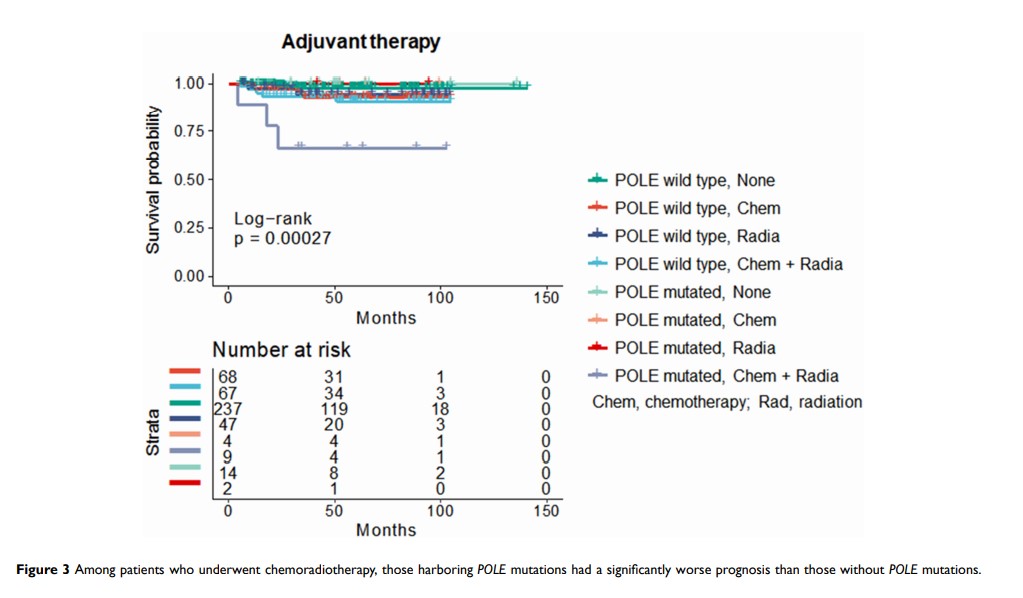9 7 7 8 0
论文已发表
注册即可获取德孚的最新动态
IF 收录期刊
- 3.3 Breast Cancer (Dove Med Press)
- 3.4 Clin Epidemiol
- 2.5 Cancer Manag Res
- 2.9 Infect Drug Resist
- 3.5 Clin Interv Aging
- 4.7 Drug Des Dev Ther
- 2.7 Int J Chronic Obstr
- 6.6 Int J Nanomed
- 2.5 Int J Women's Health
- 2.5 Neuropsych Dis Treat
- 2.7 OncoTargets Ther
- 2.0 Patient Prefer Adher
- 2.3 Ther Clin Risk Manag
- 2.5 J Pain Res
- 2.8 Diabet Metab Synd Ob
- 2.8 Psychol Res Behav Ma
- 3.0 Nat Sci Sleep
- 1.8 Pharmgenomics Pers Med
- 2.7 Risk Manag Healthc Policy
- 4.2 J Inflamm Res
- 2.1 Int J Gen Med
- 4.2 J Hepatocell Carcinoma
- 3.7 J Asthma Allergy
- 1.9 Clin Cosmet Investig Dermatol
- 2.7 J Multidiscip Healthc

一项中国队列研究所显示的子宫内膜癌的 POLE 突变特征
Authors Li Y, He Q, Li S, Wen X, Ye L, Wang K, Wan X
Received 17 April 2020
Accepted for publication 15 July 2020
Published 28 July 2020 Volume 2020:13 Pages 7305—7316
DOI https://doi.org/10.2147/OTT.S258642
Checked for plagiarism Yes
Review by Single anonymous peer review
Peer reviewer comments 2
Editor who approved publication: Dr William Cho
Objective: To study the characteristics of polymerase epsilon (POLE ) exonuclease domain mutations in Chinese patients with endometrial carcinoma (EC).
Methods: This study analyzed data from 529 patients with EC in The Cancer Genome Atlas (TCGA) and 467 EC patients evaluated at the Shanghai First Maternity and Infant Hospital (SFMIH). POLE mutation heterogeneity was analyzed in paired curettage and hysterectomy samples from 120 SFMIH patients. Sanger sequencing identified mutations in the POLE exonuclease domain, and correlations between POLE mutation status and various clinicopathological features were determined by chi-squared testing and Cohen’s kappa analysis, with Kaplan–Meier survival curves generated to assess correlations between POLE mutation status and overall survival (OS).
Results: Thirty-five mutations were identified in 467 samples (7.5%), and novel mutations were detected in the SFMIH cohort. Compared to the TCGA cohort, the SFMIH cohort had fewer POLE mutations when matched by age (< 60) and histology (endometrioid) (p < 0.001 and p = 0.010, respectively). In our study cohort, POLE mutations were significantly associated with adjuvant treatment (p = 0.029), and patients with POLE mutations who underwent chemoradiotherapy had a poor OS (p < 0.0001). Notably, shorter OS was significantly associated with POLE mutations in hysterectomy samples from patients aged > 60 years or with stage I disease in the paired curettage-hysterectomy group.
Conclusion: The significant difference in POLE mutation profiles between the TCGA and SFMIH cohorts, as well as the poor consistency between the curettage and hysterectomy samples, suggests that different parameters need to be applied to determine the prognosis of patients with EC in China.
Keywords: endometrial carcinoma, polymerase epsilon mutation, POLE mutation, Chinese cohort, hysterectomy, curettage specimens
